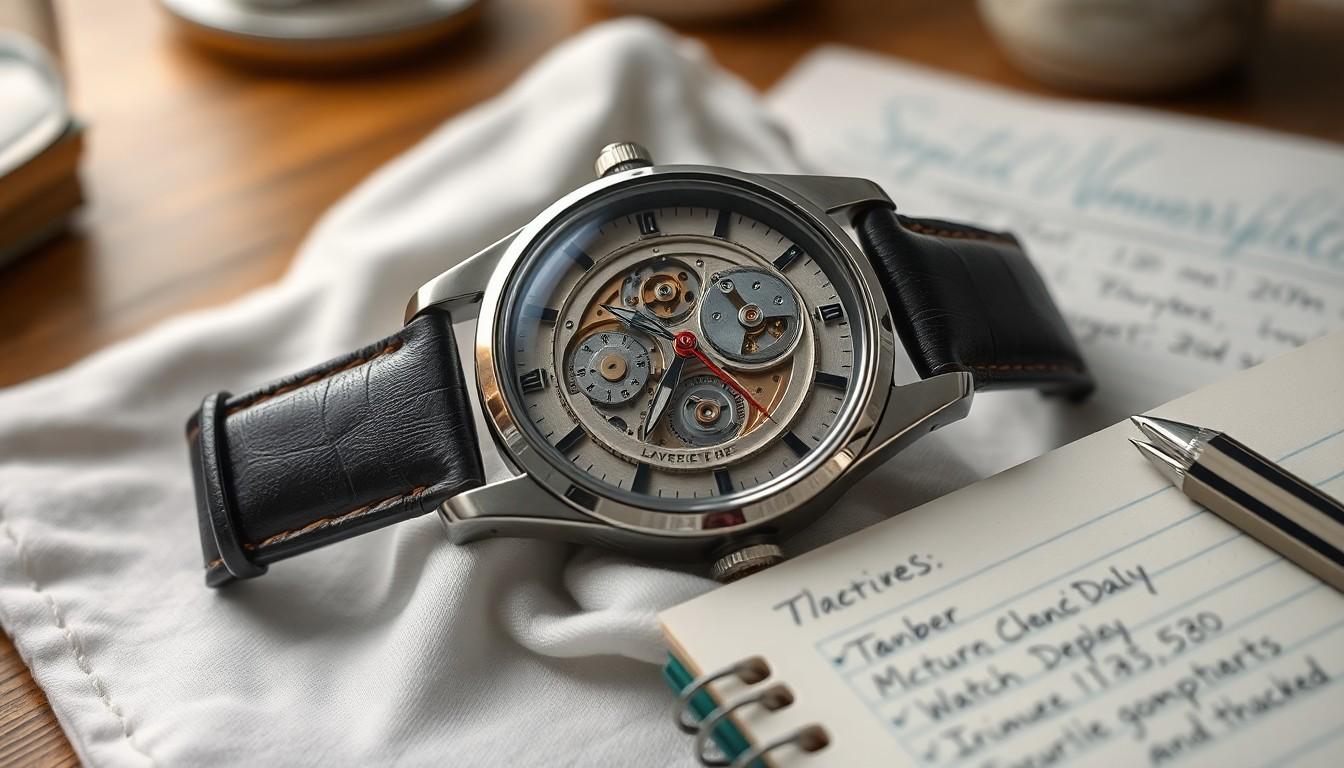Key Takeaways
- Understanding First Watch Hours: The first watch hours refer to the initial 24 hours after winding or setting a watch, crucial for achieving accurate timekeeping and performance.
- Impact on Daily Life: Awareness of first watch hours can influence lifestyle decisions, such as planning meals and social events, ensuring punctuality and effectiveness in daily activities.
- Tracking Benefits: Keeping track of first watch hours can enhance sleep quality and improve day-to-day productivity by helping users align their routines with the expected performance of their watch.
- Effective Monitoring: Utilize specific tools and apps, like WatchTracker and TimeChart, to monitor performance, and establish a systematic schedule for checking watch accuracy throughout the first day.
- Common Mistakes to Avoid: Consistency is key when tracking; neglecting the environment or using inconsistent methods can lead to inaccurate monitoring and misunderstandings regarding watch performance.
When you first dive into the world of watches, understanding “first watch hours” can make a big difference in how you appreciate your timepiece. These initial hours after winding or setting your watch are crucial for its performance and accuracy. Knowing what to expect can enhance your experience and help you care for your watch properly.
Whether you’re a seasoned collector or a newbie, grasping the concept of first watch hours will guide you in maintaining your watch’s longevity. You’ll learn how these hours affect winding, timekeeping, and overall functionality. So let’s explore this fascinating aspect of horology and ensure your watch runs smoothly from the very start.
Understanding First Watch Hours
First watch hours refer to the critical timeframe immediately following the winding or setting of a watch. During these hours, a watch’s performance and accuracy can fluctuate before stabilizing. Gaining a clear understanding of this period enhances your appreciation and care for your timepiece.
Definition of First Watch Hours
First watch hours encompass the initial 24 hours after a watch has been wound or set. During this period, the mechanical components of the watch begin to establish their frequency and oscillation patterns. These preliminary hours are crucial as various factors, including lubrication and internal tension, play significant roles in the timekeeping accuracy. The watch’s performance should stabilize as the mechanisms adapt, allowing for more reliable functionality in the long term.
Importance for Lifestyle and Sleep Patterns
First watch hours hold significance not just for accuracy but also for lifestyle and sleep patterns. With many individuals relying on their timepieces for daily schedules, understanding these hours informs how you manage your time. For example, a watch may temporarily drift from accuracy during the initial setting, affecting your punctuality for meals or appointments. Recognizing this fluctuation allows you to adjust your expectations and routines, ensuring you’re not caught off guard by potential time discrepancies.
| Time Period | Importance |
|---|---|
| Breakfast Hours | Discover how early inaccuracies can affect your morning schedule. |
| Lunch Hours | Ensure punctuality during midday breaks by monitoring first watch hours. |
| Dinner Hours | Understand the impact on evening plans and gatherings. |
| Holiday Hours | Plan festive events accordingly, considering potential watch performance variations. |
Benefits of Tracking First Watch Hours
Tracking first watch hours offers several advantages that enhance your experience with a timepiece. Understanding these benefits clarifies the importance of monitoring your watch’s initial performance post-winding or setting.
Enhanced Sleep Quality
Monitoring first watch hours helps establish routine consistency, which can improve sleep quality. Knowing how your watch performs after winding allows you to synchronize your bedtime and wake-up routine accurately. For example, if you set the watch before sleep, you’ll have confidence in its timekeeping during your sleep hours. By aligning your first watch hours with your sleep schedule, you can track sleep cycles more effectively, reducing disturbances caused by time-related inaccuracies.
Improved Productivity
Awareness of your watch’s initial timekeeping performance can elevate daily productivity. Early inaccuracies may lead to mismanaged schedules, affecting work, meetings, and appointments. Adjusting your daily routines based on first watch hours ensures you’re prepared for lunch hours, dinner events, and other crucial engagements. Keeping track of these hours also aids in effective planning for holidays, as deviations in time can disrupt various activities.
| Time of Day | Activity | Importance |
|---|---|---|
| 7:00 AM – 10:00 AM | Breakfast Hours | Sets the tone for the day |
| 12:00 PM – 2:00 PM | Lunch Hours | Maintains energy for afternoon tasks |
| 5:00 PM – 8:00 PM | Dinner Hours | Aids in social connections |
| Varies (Holidays) | Holiday Hours | Ensures participation in events |
How to Effectively Track First Watch Hours
Tracking first watch hours involves understanding how various factors impact your watch’s performance. Accurate monitoring ensures optimal timekeeping throughout the day.
Recommended Tools and Apps
Utilize specific tools and apps designed for tracking watch hours effectively. Consider the following:
| Tool/App | Description |
|---|---|
| WatchTracker | Records initial performance metrics for watches. |
| TimeChart | Visualizes watch accuracy over specified intervals. |
| Chronosys | Logs first watch hours and provides notifications. |
| WatchOS | Syncs with your smart device for real-time tracking. |
These tools help you keep an eye on performance fluctuations and adjust your routines accordingly.
Tips for Accurate Monitoring
Follow these tips to ensure precise monitoring of your watch’s first hours:
- Set a Schedule: Note the watch’s winding time and plan your activities around it.
- Compare Performance: Evaluate timekeeping accuracy at intervals, such as breakfast (7 AM – 10 AM), lunch (11 AM – 2 PM), and dinner (5 PM – 8 PM).
- Regular Checks: Monitor your watch’s accuracy every few hours, especially during the first 24 hours.
- Record Data: Document any discrepancies to identify patterns that affect your watch’s performance.
Paying attention to these nuances helps maintain your watch’s reliability and keeps your routine uninterrupted.
Common Mistakes to Avoid
Understanding first watch hours is essential, but several common mistakes can hinder your monitoring efforts. Avoiding these pitfalls can significantly enhance the performance and accuracy of your watch.
Overlooking Sleep Environment
Ignoring your sleep environment can lead to inaccurate tracking of your watch. A consistent sleep environment helps maintain regularity, which influences your body’s natural clock and enhances your awareness of time discrepancies. Factors like light, temperature, and noise can disrupt sleep quality. Ensuring a dark, quiet, and comfortable sleep area can optimize your watch’s performance, particularly during early hours.
Inconsistent Tracking Methods
Inconsistency in tracking your watch performance can create confusion. Establishing a regular method for recording time variations is crucial for accurate monitoring. Utilize tools and apps to log data systematically. By maintaining consistent tracking intervals, such as daily checks during breakfast, lunch, and dinner hours, you can better identify fluctuations. Ensure that you document and analyze these observations to boost your understanding of your watch’s performance.
| Meal Type | Typical Timing | First Watch Hour Monitoring Activity |
|---|---|---|
| Breakfast | 6:00 AM – 10:30 AM | Check watch performance at 6:30 AM and log results |
| Lunch | 11:30 AM – 2:30 PM | Review time accuracy at 12:00 PM and note any changes |
| Dinner | 5:30 PM – 9:00 PM | Monitor watch and compare at 7:00 PM |
| Holiday Hours | Varies by holiday or occasion | Track additional variations post-winding |
Conclusion
Understanding first watch hours is key to maximizing your watch’s performance and accuracy. By paying attention to these initial 24 hours after winding or setting, you can better appreciate the intricate mechanics at play. This awareness not only helps in maintaining your timepiece but also allows you to adjust your daily routines to minimize disruptions caused by potential inaccuracies.
Utilizing tools and methods to track these hours can lead to improved synchronization with your lifestyle. With a little effort and attention, you can ensure your watch serves you well, keeping you on schedule and enhancing your overall time management. Embrace the journey of watch ownership and make the most of those crucial first hours.
Frequently Asked Questions
What are first watch hours?
First watch hours refer to the initial 24 hours after winding or setting a watch. During this period, the watch’s performance and accuracy can fluctuate as its mechanical components adjust and stabilize their frequency and oscillation patterns.
Why are first watch hours important?
Understanding first watch hours is essential because it impacts a watch’s timekeeping accuracy and functionality. Recognizing these fluctuations can help users manage their expectations and schedules, ensuring they aren’t caught off guard by potential time discrepancies.
How do first watch hours affect daily life?
First watch hours can affect daily routines such as meal times and sleep schedules. Inaccuracies during this initial period may disrupt planning for important events, which can lead to inefficiencies in daily activities.
What tools can help track first watch hours?
Several tools and apps can help track first watch hours, including WatchTracker, TimeChart, Chronosys, and WatchOS. These applications allow users to monitor performance fluctuations and adjust their routines accordingly for better accuracy.
How can I effectively monitor first watch hours?
To effectively monitor first watch hours, establish a winding schedule, compare performance at key intervals, conduct regular checks, and document any discrepancies. This systematic approach will enhance your understanding of your watch’s performance.
What common mistakes should I avoid when tracking first watch hours?
Common mistakes to avoid include inconsistent tracking methods and neglecting to maintain a stable sleep environment. Establishing a regular logging system will help identify fluctuations and improve the overall understanding of your watch’s performance.




Leave a Reply